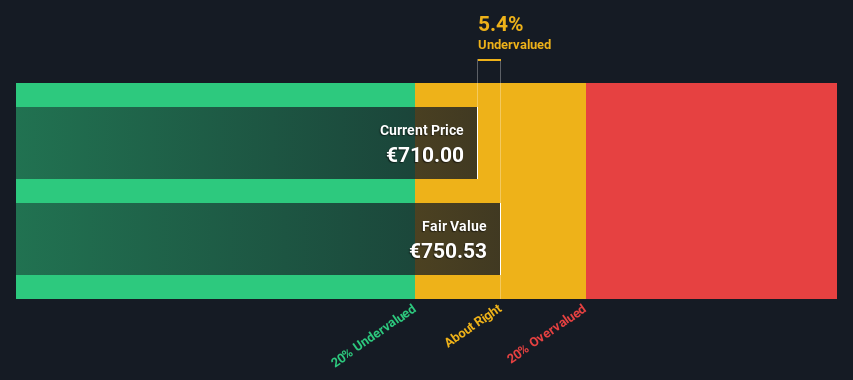Calculating The Fair Value Of LVMH Moët Hennessy - Louis Vuitton, Société Européenne (EPA:MC)

Key Insights
- Using the 2 Stage Free Cash Flow to Equity, LVMH Moët Hennessy - Louis Vuitton Société Européenne fair value estimate is €751
- With €710 share price, LVMH Moët Hennessy - Louis Vuitton Société Européenne appears to be trading close to its estimated fair value
- Our fair value estimate is 13% lower than LVMH Moët Hennessy - Louis Vuitton Société Européenne's analyst price target of €865
In this article we are going to estimate the intrinsic value of LVMH Moët Hennessy - Louis Vuitton, Société Européenne (EPA:MC) by taking the expected future cash flows and discounting them to their present value. This will be done using the Discounted Cash Flow (DCF) model. There's really not all that much to it, even though it might appear quite complex.
We would caution that there are many ways of valuing a company and, like the DCF, each technique has advantages and disadvantages in certain scenarios. For those who are keen learners of equity analysis, the Simply Wall St analysis model here may be something of interest to you.
See our latest analysis for LVMH Moët Hennessy - Louis Vuitton Société Européenne
Is LVMH Moët Hennessy - Louis Vuitton Société Européenne Fairly Valued?
We are going to use a two-stage DCF model, which, as the name states, takes into account two stages of growth. The first stage is generally a higher growth period which levels off heading towards the terminal value, captured in the second 'steady growth' period. In the first stage we need to estimate the cash flows to the business over the next ten years. Where possible we use analyst estimates, but when these aren't available we extrapolate the previous free cash flow (FCF) from the last estimate or reported value. We assume companies with shrinking free cash flow will slow their rate of shrinkage, and that companies with growing free cash flow will see their growth rate slow, over this period. We do this to reflect that growth tends to slow more in the early years than it does in later years.
A DCF is all about the idea that a dollar in the future is less valuable than a dollar today, and so the sum of these future cash flows is then discounted to today's value:
10-year free cash flow (FCF) forecast
| 2025 | 2026 | 2027 | 2028 | 2029 | 2030 | 2031 | 2032 | 2033 | 2034 | |
| Levered FCF (€, Millions) | €17.0b | €18.6b | €19.3b | €21.5b | €22.7b | €23.6b | €24.4b | €25.0b | €25.6b | €26.0b |
| Growth Rate Estimate Source | Analyst x13 | Analyst x9 | Analyst x1 | Analyst x1 | Est @ 5.53% | Est @ 4.20% | Est @ 3.26% | Est @ 2.61% | Est @ 2.15% | Est @ 1.83% |
| Present Value (€, Millions) Discounted @ 7.1% | €15.9k | €16.2k | €15.7k | €16.3k | €16.1k | €15.7k | €15.1k | €14.5k | €13.8k | €13.1k |
("Est" = FCF growth rate estimated by Simply Wall St)
Present Value of 10-year Cash Flow (PVCF) = €152b
After calculating the present value of future cash flows in the initial 10-year period, we need to calculate the Terminal Value, which accounts for all future cash flows beyond the first stage. The Gordon Growth formula is used to calculate Terminal Value at a future annual growth rate equal to the 5-year average of the 10-year government bond yield of 1.1%. We discount the terminal cash flows to today's value at a cost of equity of 7.1%.
Terminal Value (TV)= FCF2034 × (1 + g) ÷ (r – g) = €26b× (1 + 1.1%) ÷ (7.1%– 1.1%) = €438b
Present Value of Terminal Value (PVTV)= TV / (1 + r)10= €438b÷ ( 1 + 7.1%)10= €221b
The total value, or equity value, is then the sum of the present value of the future cash flows, which in this case is €373b. The last step is to then divide the equity value by the number of shares outstanding. Compared to the current share price of €710, the company appears about fair value at a 5.4% discount to where the stock price trades currently. The assumptions in any calculation have a big impact on the valuation, so it is better to view this as a rough estimate, not precise down to the last cent.

The Assumptions
The calculation above is very dependent on two assumptions. The first is the discount rate and the other is the cash flows. Part of investing is coming up with your own evaluation of a company's future performance, so try the calculation yourself and check your own assumptions. The DCF also does not consider the possible cyclicality of an industry, or a company's future capital requirements, so it does not give a full picture of a company's potential performance. Given that we are looking at LVMH Moët Hennessy - Louis Vuitton Société Européenne as potential shareholders, the cost of equity is used as the discount rate, rather than the cost of capital (or weighted average cost of capital, WACC) which accounts for debt. In this calculation we've used 7.1%, which is based on a levered beta of 1.128. Beta is a measure of a stock's volatility, compared to the market as a whole. We get our beta from the industry average beta of globally comparable companies, with an imposed limit between 0.8 and 2.0, which is a reasonable range for a stable business.
SWOT Analysis for LVMH Moët Hennessy - Louis Vuitton Société Européenne
- Debt is not viewed as a risk.
- Dividends are covered by earnings and cash flows.
- Earnings growth over the past year underperformed the Luxury industry.
- Dividend is low compared to the top 25% of dividend payers in the Luxury market.
- Annual revenue is forecast to grow faster than the French market.
- Good value based on P/E ratio and estimated fair value.
- Annual earnings are forecast to grow slower than the French market.
Looking Ahead:
Although the valuation of a company is important, it ideally won't be the sole piece of analysis you scrutinize for a company. The DCF model is not a perfect stock valuation tool. Rather it should be seen as a guide to "what assumptions need to be true for this stock to be under/overvalued?" For example, changes in the company's cost of equity or the risk free rate can significantly impact the valuation. For LVMH Moët Hennessy - Louis Vuitton Société Européenne, we've compiled three pertinent factors you should look at:
- Financial Health: Does MC have a healthy balance sheet? Take a look at our free balance sheet analysis with six simple checks on key factors like leverage and risk.
- Future Earnings: How does MC's growth rate compare to its peers and the wider market? Dig deeper into the analyst consensus number for the upcoming years by interacting with our free analyst growth expectation chart.
- Other Solid Businesses: Low debt, high returns on equity and good past performance are fundamental to a strong business. Why not explore our interactive list of stocks with solid business fundamentals to see if there are other companies you may not have considered!
PS. Simply Wall St updates its DCF calculation for every French stock every day, so if you want to find the intrinsic value of any other stock just search here.
If you're looking to trade LVMH Moët Hennessy - Louis Vuitton Société Européenne, open an account with the lowest-cost platform trusted by professionals, Interactive Brokers.
With clients in over 200 countries and territories, and access to 160 markets, IBKR lets you trade stocks, options, futures, forex, bonds and funds from a single integrated account.
Enjoy no hidden fees, no account minimums, and FX conversion rates as low as 0.03%, far better than what most brokers offer.
Sponsored ContentNew: AI Stock Screener & Alerts
Our new AI Stock Screener scans the market every day to uncover opportunities.
• Dividend Powerhouses (3%+ Yield)
• Undervalued Small Caps with Insider Buying
• High growth Tech and AI Companies
Or build your own from over 50 metrics.
Have feedback on this article? Concerned about the content? Get in touch with us directly. Alternatively, email editorial-team (at) simplywallst.com.
This article by Simply Wall St is general in nature. We provide commentary based on historical data and analyst forecasts only using an unbiased methodology and our articles are not intended to be financial advice. It does not constitute a recommendation to buy or sell any stock, and does not take account of your objectives, or your financial situation. We aim to bring you long-term focused analysis driven by fundamental data. Note that our analysis may not factor in the latest price-sensitive company announcements or qualitative material. Simply Wall St has no position in any stocks mentioned.
Have feedback on this article? Concerned about the content? Get in touch with us directly. Alternatively, email editorial-team@simplywallst.com
About ENXTPA:MC
LVMH Moët Hennessy - Louis Vuitton Société Européenne
Operates as a luxury goods company worldwide.
Excellent balance sheet, good value and pays a dividend.
Market Insights
Community Narratives


